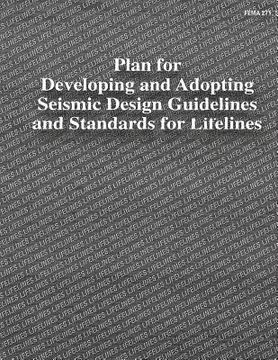Plan for Developing and Adopting Seismic Design Guidelines and Standards for Lifelines (FEMA 271) (en Inglés)
Reseña del libro "Plan for Developing and Adopting Seismic Design Guidelines and Standards for Lifelines (FEMA 271) (en Inglés)"
Although earthquakes are an inevitable hazard, they are not inevitable disasters. Experiences in recent years have shown consistently that lifelines properly designed to resist earthquakes perform well in spite of severe earthquakes; those not so designed are subject to failure. Assessments of earthquake hazards indicate that one or more severe earthquakes can be expected to strike U.S. metropolitan areas in the next decade. Until actions are taken to improve the design and construction of lifelines, failures can be expected to result in substantial losses--estimated at billions of dollars and many lives for a single severe earthquake. The plan described in this document defines a process that, if activated, will begin the development of seismic design guidelines and standards for both new and existing lifelines. Lifelines are the public works and utility systems that support most human activities: individual, family, economic, political, and cultural. The various lifelines can be classified under the following five systems: electric power, gas and liquid fuels, telecommunications, transportation, and water supply and sewers. This plan for developing and adopting seismic design and construction guidelines and standards for lifelines has been prepared in response to Public Law 101-614, the National Earthquake Hazards Reduction Program (NEHRP) Reauthorization Act. The act requires the Federal Emergency Management Agency (FEMA), in consultation with the National Institute of Standards and Technology (NIST), to develop "a plan, including precise timetables and budget estimates, for developing and adopting, in consultation with appropriate private sector organizations, design and construction standards for lifelines" and "recommendations of ways Federal regulatory authority could be used to expedite the implementation of such standards." The Plan focuses on developing recommendations, encouraging and supporting the approval of these recommendations by the standards and professional organizations serving the lifeline community, and working with the lifeline community to achieve their effective implementation. Design guidelines lay out a set of principles, which for lifelines may include performance criteria, materials characteristics, and testing procedures for design, construction, maintenance, repair, and retrofitting of both existing and proposed systems. Guidelines provide a basis for making judgments or determining a course of action; they may evolve into recommendations for standards. A standard, according to the National Standards Policy Advisory Committee, is "a prescribed set of rules, conditions, or requirements concerning definitions of terms; classification of components; specification of materials, performance, or operation; delineation of procedures; or measurement of quantity and quality in describing materials, products, systems, services, or practices." Properly developed and effectively implemented lifeline seismic guidelines and standards will significantly reduce the vulnerability of both existing and proposed lifeline systems to future earthquakes. Guidelines and standards should (1) establish performance criteria for the construction, maintenance, and operation of existing and proposed lifeline systems, equipment, and materials for selected levels of seismic risk; (2) provide a basis for technical specifications for use by buyers and sellers of lifeline products and services to reduce the vulnerability of lifeline systems to earthquakes; and (3) provide a reliable basis for regulations to protect the public health, safety, and welfare.

